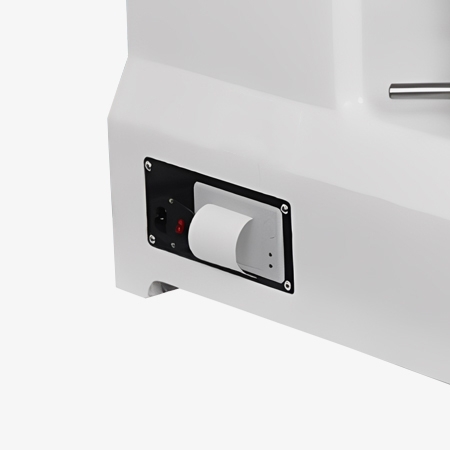Unlike traditional testers, which rely on manual readings and calculations, this device incorporates a digital interface with a touch screen, making operation intuitive and precise. Equipped with a high-performance stepper motor, resulting in lower noise during operation. This kind of hardness testing machine is widely used in metal manufacturing, quality control, and research laboratory, as it provide fast and accurate results.

Equipped With a Built-in Printer
- Enhanced Efficiency and Productivity. The integration of digital readouts and built-in printers streamlines the testing process. Operators can perform tests, record results, and generate reports all in one continuous workflow without the need to manually transcribe data. This efficiency not only saves time but also reduces the workload on staff.
- Immediate and Accurate Data Output. One of the most significant advantages of Brinell tester having a built-in printer is the ability to instantly print the hardness test results directly after each measurement. This eliminates the risk of manual recording errors that often occur during transcription from the digital display to paper or digital records.

BHN Hardness Tester Adopts Cast Iron Housing
- Enhanced Durability and Strength. Cast iron is known for its excellent strength and rigidity. A digital Brinell hardness tester with a cast iron housing can withstand heavy usage in industrial environments without deforming or sustaining damage.
- Corrosion Resistance and Longevity. Quality cast iron provides resistance to corrosion and environmental wear. This is particularly important in workshops and factories where exposure to dust, moisture, or oils is common. The cast iron housing helps the tester maintain structural integrity over years of use, reducing the need for frequent maintenance or replacement.
Applications
SISCO's Brinell hardness tester is widely used to measure the hardness of metals, making it essential in quality control, material testing, and engineering applications. Its main application fields include metallurgy, where it helps evaluate the mechanical properties of steel, cast iron, and non-ferrous metals. Additionally, the Brinell hardness test is applied in research and development.

Automobile Industry

Mechanical Manufacturing

Metallurgical Industry

Laboratory
| Model | SISCO-HT-HBTS-3000Z |
| Brinel Scale | HBW2.5/62.5, HBW2.5/187.5, HBW5/62.5, HBW5/125, HBW5/250, HBW5/750, HBW10/100, HBW10/250, HBW10/500, HBW10/1000, HBW10/1500, HBW10/3000 |
| Test Force | 62.5kgf(612.9N), 100kgf(980.7N), 125kgf(1226N), 187.5kgf(1839N), 250kgf(2452N), 500kgf(4903N), 750kgf(7355N), 1000kgf(8907N), 1500kgf(14710N), 3000kgf(29420N) |
| Load Control | Automatic (loading/holding/unloading) |
| Maximum Height of Test Piece | 220mm |
| Indenter-Outer Wall Distance | 135mm |
| Indenter-Upper Wall Distance | 55mm |
| Minimum Measurement Unit | 0.125um |
| Dwell Time | 0~60s |
| Hardness Testing Range | 3.18~653HBW |
| Total Magnification | 20X |
| Hardness Reading | Automatic calculation |
| Data Output | Built-in printer |
| Power Supply | AC 110V/220V |
| Dimension | 520*210*745mm |
| Weight | About 125kg(main unit) |
Q1: What is a Brinell hardness tester?
A1: A Brinell hardness tester is a device used to measure the hardness of materials, especially metals. It works by pressing a hard, spherical indenter, usually made of steel, into the surface of a material under a specific load. The size of the indentation left on the material is measured, and the Brinell hardness number (BHN) is calculated.
Q2: What materials can be tested with a Brinell hardness tester?
A2: A BHN hardness tester is primarily used to measure the hardness of metals and alloys. Common materials tested include steel, cast iron, aluminum, copper, and non-ferrous alloys. Brinell testing is less effective for very hard materials.
Q3: What safety precautions should be taken when using a digital Brinell hardness tester?
A3: When using a digital Brinell hardness tester, always wear safety goggles and gloves to protect against metal fragments or accidental contact. Operate the machine on a clean, dry surface to avoid slips. Disconnect power before maintenance or adjustments. Finally, maintain a safe distance for bystanders to prevent injury from flying debris or sudden movements of the tester.
Tips: How to store a Brinell hardness tester properly?
Cleaning the Brinell hardness tester after each use, removing any debris, dust, or metal particles from the indenter and body using a soft, lint-free cloth. Store the tester in a dry, temperature-controlled environment to prevent corrosion and thermal expansion, ideally in its original case or a padded storage box. Keep it away from direct sunlight, humidity, and sources of vibration or impact.
Thank you for buying industrial test and measurement equipment on SISCO.com, all products sold by SISCO and the partner cover a 12 months warranty, effective from the date of receiving the products.
What is covered?
SISCO is responsible for providing free spare parts, and free technical support to assist the customer to repair the defective products until the problem is solved.
What is not covered?
- Product purchased from anyone other than a SISCO store or a SISCO authorized reseller.
- Expendable parts.
- Routine cleaning or normal cosmetic and mechanical wear.
- Damage from misuse, abuse or neglect.
- Damage from use of parts other than SISCO approved.
- Damage from use outside the product’s usage or storage parameters.
- Damage from use of parts not sold by SISCO.
- Damage from modification or incorporation into other products.
- Damage from repair or replacement of warranted parts by a service provider other than a SISCO authorized service provider.
- Damage caused by the application environment not meeting the product usage requirements and the failure to perform preventive maintenance.

